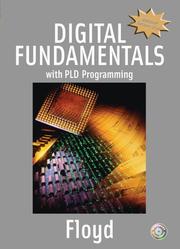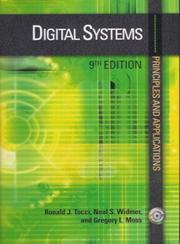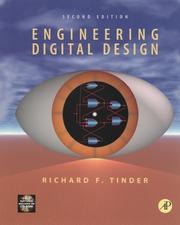| Listing 1 - 10 of 33 | << page >> |
Sort by
|

ISBN: 0131701886 Year: 2006 Publisher: Upper Saddle River, N.J. Pearson Prentice Hall
Abstract | Keywords | Export | Availability | Bookmark
 Loading...
Loading...Choose an application
- Reference Manager
- EndNote
- RefWorks (Direct export to RefWorks)
Electronics --- PLD (Programmable Logic Device) --- digitale elektronica
Book
ISBN: 9020119273 Year: 1986 Publisher: Deventer Kluwer
Abstract | Keywords | Export | Availability | Bookmark
 Loading...
Loading...Choose an application
- Reference Manager
- EndNote
- RefWorks (Direct export to RefWorks)
Logiciels --- Software --- 681.31 --- IFL --- PAL --- PLD programmable logic design --- digitale elektronica --- elektronica --- elektrotechniek --- hardware --- ontwerpen --- programmeerbare logica --- programmeren --- Computerarchitectuur. Informaticahardware --- PAL (programmable array logic) --- Computer. Automation --- Computer architecture. Operating systems --- digitale schakelingen --- PLD (Programmable Logic Device)
Book
ISBN: 9780135018101 Year: 2009 Publisher: Upper Saddle River, N.J. Pearson Education
Abstract | Keywords | Export | Availability | Bookmark
 Loading...
Loading...Choose an application
- Reference Manager
- EndNote
- RefWorks (Direct export to RefWorks)
Book
ISBN: 0137238347 Year: 1991 Publisher: Englewood Cliffs, N.J. Prentice Hall
Abstract | Keywords | Export | Availability | Bookmark
 Loading...
Loading...Choose an application
- Reference Manager
- EndNote
- RefWorks (Direct export to RefWorks)
Book
ISBN: 9039501831 Year: 1995 Publisher: Schoonhoven Academic Service
Abstract | Keywords | Export | Availability | Bookmark
 Loading...
Loading...Choose an application
- Reference Manager
- EndNote
- RefWorks (Direct export to RefWorks)
Production management --- systems engineering --- Computer architecture. Operating systems --- Digitale Elektronica --- digitale technieken --- bouwstenen --- synchrone machines --- top-down aanpak --- asynchrone machines --- geheugen --- architectuur --- logica --- SSI --- msi --- PLD --- pga --- ADC --- DAC

ISBN: 0131219316 0131111205 Year: 2004 Publisher: Upper Saddle River, N.J. Pearson Prentice Hall
Abstract | Keywords | Export | Availability | Bookmark
 Loading...
Loading...Choose an application
- Reference Manager
- EndNote
- RefWorks (Direct export to RefWorks)
programmeertalen --- digitale technieken --- digitalisering --- Electronics --- Computer architecture. Operating systems --- Digital electronics --- digitale techniek --- flipflop --- ic --- interface --- microcomputer --- microprocessor --- pld (programmable logic devices) --- Digital circuits --- Digital techniques (Electronics) --- Electronic systems --- (zie ook: chip) --- Contains audio-visual material

ISBN: 0126912955 9780126912951 1281028282 9781281028280 9786611028282 6611028285 0080505651 9780080505657 0585470480 9780585470481 Year: 2000 Publisher: San Diego Academic Press
Abstract | Keywords | Export | Availability | Bookmark
 Loading...
Loading...Choose an application
- Reference Manager
- EndNote
- RefWorks (Direct export to RefWorks)
Production management --- Computer. Automation --- engineering --- computers --- Digital electronics --- Logic design --- digitale techniek --- pld (programmable logic devices) --- Design, Logic --- Design of logic systems --- Electronic circuit design --- Logic circuits --- Machine theory --- Switching theory --- Digital circuits --- Digital techniques (Electronics) --- Electronic systems --- Electronics
Book
ISBN: 9780138146467 Year: 2009 Publisher: Upper Saddle River, N.J. Pearson
Abstract | Keywords | Export | Availability | Bookmark
 Loading...
Loading...Choose an application
- Reference Manager
- EndNote
- RefWorks (Direct export to RefWorks)
Electronics --- Computer architecture. Operating systems --- PLD (Programmable Logic Device) --- FPGA (field programmable gate array) --- flipflop --- elektronica --- digitale technieken --- combinatorische logica --- 621.377.6 --- Digitale technieken --- digitale elektronica --- digitale systemen --- digitale geheugens --- Contains audio-visual material
Book
Year: 2021 Publisher: Basel, Switzerland MDPI - Multidisciplinary Digital Publishing Institute
Abstract | Keywords | Export | Availability | Bookmark
 Loading...
Loading...Choose an application
- Reference Manager
- EndNote
- RefWorks (Direct export to RefWorks)
Despite its limitation in terms of surface covered area, the PLD technique still gathers interest among researchers by offering endless possibilities for tuning thin film composition and enhancing their properties of interest due to: (i) the easiness of a stoichiometric transfer even for very complex target materials, (ii) high adherence of the deposited structures to the substrate, (iii) controlled degree of phase, crystallinity, and thickness of deposited coatings, (iv) versatility of the experimental set-up which allows for simultaneous ablation of multiple targets resulting in combinatorial maps or consecutive ablation of multiple targets producing multi-layered structures, and (v) adjustment of the number of laser pulses, resulting in either a spread of nanoparticles, islands of materials or a complete covering of a surface. Moreover, a variation of PLD, known as Matrix Assisted Pulsed Laser Evaporation, allows for deposition of organic materials, ranging from polymers to proteins and even living cells, otherwise difficult to transfer unaltered in the form of thin films by other techniques. Furthermore, the use of laser light as transfer agent ensures purity of films and pulse-to-pulse deposition allows for an unprecedented control of film thickness at the nm level. This Special Issue is a collection of state-of-the art research papers and reviews in which the topics of interest are devoted to thin film synthesis by PLD and MAPLE, for numerous research and industry field applications, such as bio-active coatings for medical implants and hard, protective coatings for cutting and drilling tools withstanding high friction and elevated temperatures, sensors, solar cells, lithography, magnetic devices, energy-storage and conversion devices, controlled drug delivery and in situ microstructuring for boosting of surface properties.
Technology: general issues --- thin films --- matrix-assisted pulsed laser evaporation --- shellac --- enteric coatings --- PLD --- ITO --- nanoimprint lithography --- coatings --- nanostructure --- iron oxide --- pulsed laser deposition --- aluminum nitride --- nanoindentation testing --- TEM imaging --- FTIR spectroscopy --- ellipsometry --- complex refractive index --- composite coatings --- MAPLE --- Lactoferrin --- macrophage interactions --- animal-origin calcium phosphate coatings --- natural hydroxyapatite --- doping --- high adherence --- pulsed laser deposition technique --- biomimetic applications --- target preparation --- room temperature ferromagnetism --- dilute magnetic semiconductor --- Indium oxide --- (InFe)2O3 --- PLD films --- energy storage --- thin-film electrodes --- thin-film solid electrolyte --- lithium microbatteries --- calcium phosphate-based coatings --- synthetic and natural hydroxyapatite --- in vivo testing --- biomedical applications --- n/a
Book
Year: 2021 Publisher: Basel, Switzerland MDPI - Multidisciplinary Digital Publishing Institute
Abstract | Keywords | Export | Availability | Bookmark
 Loading...
Loading...Choose an application
- Reference Manager
- EndNote
- RefWorks (Direct export to RefWorks)
Despite its limitation in terms of surface covered area, the PLD technique still gathers interest among researchers by offering endless possibilities for tuning thin film composition and enhancing their properties of interest due to: (i) the easiness of a stoichiometric transfer even for very complex target materials, (ii) high adherence of the deposited structures to the substrate, (iii) controlled degree of phase, crystallinity, and thickness of deposited coatings, (iv) versatility of the experimental set-up which allows for simultaneous ablation of multiple targets resulting in combinatorial maps or consecutive ablation of multiple targets producing multi-layered structures, and (v) adjustment of the number of laser pulses, resulting in either a spread of nanoparticles, islands of materials or a complete covering of a surface. Moreover, a variation of PLD, known as Matrix Assisted Pulsed Laser Evaporation, allows for deposition of organic materials, ranging from polymers to proteins and even living cells, otherwise difficult to transfer unaltered in the form of thin films by other techniques. Furthermore, the use of laser light as transfer agent ensures purity of films and pulse-to-pulse deposition allows for an unprecedented control of film thickness at the nm level. This Special Issue is a collection of state-of-the art research papers and reviews in which the topics of interest are devoted to thin film synthesis by PLD and MAPLE, for numerous research and industry field applications, such as bio-active coatings for medical implants and hard, protective coatings for cutting and drilling tools withstanding high friction and elevated temperatures, sensors, solar cells, lithography, magnetic devices, energy-storage and conversion devices, controlled drug delivery and in situ microstructuring for boosting of surface properties.
thin films --- matrix-assisted pulsed laser evaporation --- shellac --- enteric coatings --- PLD --- ITO --- nanoimprint lithography --- coatings --- nanostructure --- iron oxide --- pulsed laser deposition --- aluminum nitride --- nanoindentation testing --- TEM imaging --- FTIR spectroscopy --- ellipsometry --- complex refractive index --- composite coatings --- MAPLE --- Lactoferrin --- macrophage interactions --- animal-origin calcium phosphate coatings --- natural hydroxyapatite --- doping --- high adherence --- pulsed laser deposition technique --- biomimetic applications --- target preparation --- room temperature ferromagnetism --- dilute magnetic semiconductor --- Indium oxide --- (InFe)2O3 --- PLD films --- energy storage --- thin-film electrodes --- thin-film solid electrolyte --- lithium microbatteries --- calcium phosphate-based coatings --- synthetic and natural hydroxyapatite --- in vivo testing --- biomedical applications --- n/a
| Listing 1 - 10 of 33 | << page >> |
Sort by
|

 Search
Search Feedback
Feedback About UniCat
About UniCat  Help
Help News
News